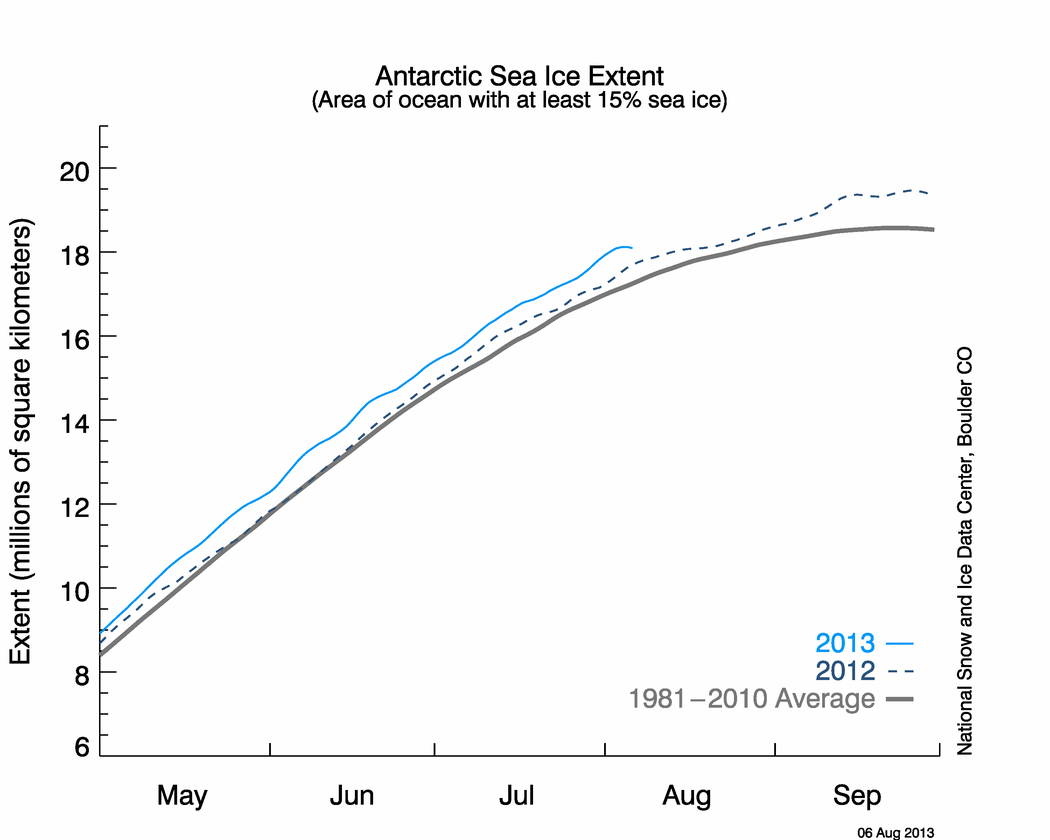 |
| http://nsidc.org/data/seaice_index/images/daily_images/S_timeseries.png |
So the contrarians are responding to the Arctic ice melt story by saying -
"Look! The Antarctic ice isn't melting its growing! What have ya got to say about that then?"
OK, let's take a look at the Antarctic. It's true, the Antarctic Sea Ice is growing.
Here is the long term trend:
 |
| IPCC |
Unexpectedly, the sea around Antarctica is warming, by 1.7*C per decade, faster than the average ocean warming, which is about 1*C per decade.
- this warming should produce more cloud,
- which should mean more precipitation
- which should cause not only an increase of precipitation on the periphery of the continent,
- also should cause a layer of fresher water on the salt sea,
- which would cause sea ice to form more easily. (Freshwater freezes at 0*C, while salt freezes at -2*C).
Second, winds and storms have increased in the area. These help with precipitation, but also they break up the ice sheets, exposing new areas of seawater to be frozen. The reason for increased storms is a colder stratosphere is to be found in the loss of the ozone layer, because ozone is a greenhouse gas (as well as being a UV filter).
Therefore it is not surprising that sea ice is growing.
But, sadly,
Antarctic Ice mass is shrinking
Satellite methods assessing the mass of ice lying on the Antarctic continent by looking at its gravity.
They find that the antarctic land mass is on a downward trend:
 |
| http://www.agu.org/pubs/crossref/2009/2009GL040222.shtml |
All of this has been happening while the Antarctic air temperature has been flat:
 |
| Climate4you.com |
Maybe that is why the temperature trend has been flat. Maybe the heat needed to sublimate or melt the Antarctic land ice has gone into removing the mass of land ice. The other explanation could be increased heat coming from Mount Erebus, Antarctica's volcano.
The Antarctic ice mass is huge. It is equivalent for one Egyptian pyramid of ice for every man woman and child on the planet, and if it all melted into the sea, it could raise sea levels by 4-6 metres (13-20 feet).
The Antarctic ice situation is by no means simple. The pathways I have sketched out above are only part of the picture. There are many other threads to be woven into the tapestry, not least what the ocean currents are up to. I have read of, and saw a graph of an temperature oscillation between North and South poles, so that when one was warm, the other was cold. I lost the page. If it turns up, I will add it here. If I was a scholar, I would check up on it before I hit Publish. As it is, I am a sadly impatient blogger, too eager to get this out there.
Anyway, for me that is enough to give a good account of what is happening in the South Pole.
It is all, unfortunately, consistent with global warming.
Note that there may be a negative correlation between Arctic and Antarctic temperatures. It comes from a sceptic, but seems to be based on data.








2 comments:
I thought the west antarctic ice sheet alone could raise sea levels by +/- 6m.
I'm thinking the WA ice sheet alone could raise sea levels 6m
Post a Comment